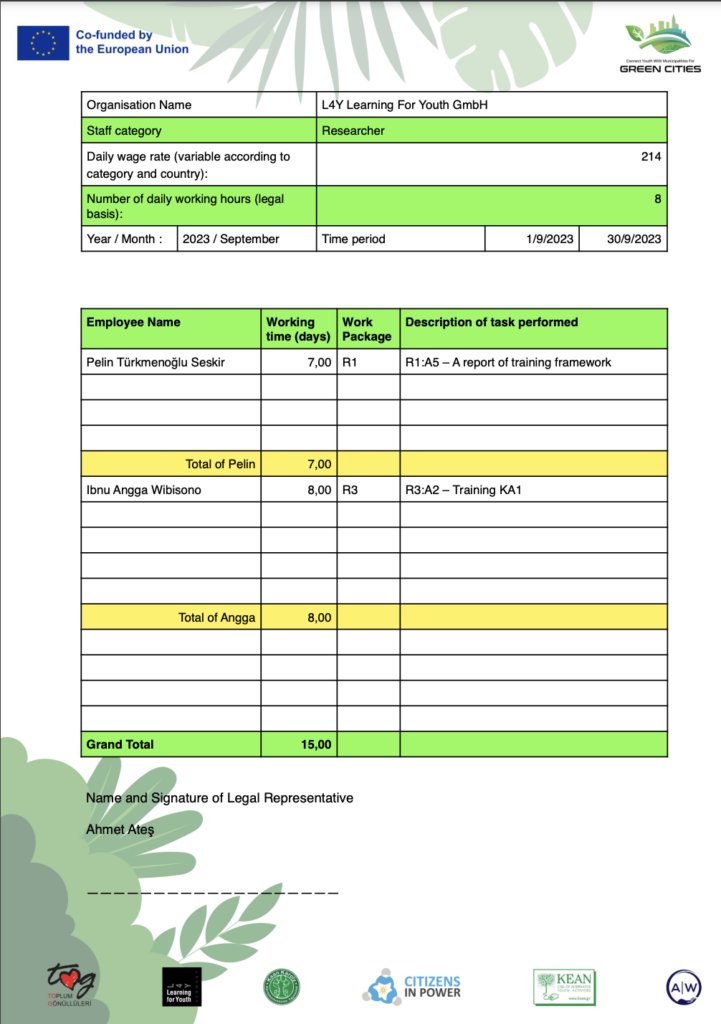In today’s dynamic project management landscape, preparing accurate timesheet reporting is crucial for the success of Erasmus+ projects. Firstly, timesheets ensure compliance with funding requirements and provide a transparent record of the time and effort invested by project participants. Moreover, this article offers detailed guidelines for project partners on effectively using timesheets within Erasmus+ projects. By following these guidelines, partners can ensure proper budget allocation, maintain comprehensive records, and streamline reporting processes. Additionally, you can find the Turkish version of this blog post here. It is essential to understand that it is German National Agencies; if your coordinator is not German, you can not use this simplified system. Ask your coordinator to learn from their NA if using the sample method we have created for Germany for your projects is possible. Some other NAs may not accept it.
Learning Objectives
By the end of this article, project partners will be able to:
Firstly, understand the importance of accurate timesheet reporting for Erasmus+ projects.
Secondly, efficiently prepare and maintain monthly timesheets for project reporting.
Furthermore, it is essential to allocate project budgets accurately for researchers, youth workers, and teachers.
Additionally, use timesheets to track multiple individuals’ contributions and ensure proper grant totals.
Finally, correctly document work packages and sub-activities.
Monthly Timesheet Preparation
Importance of Accurate Timesheet Reporting
Researchers, youth workers, and teachers must use timesheets to document their time on various project activities. Moreover, each organisation must fill out monthly timesheets to record their work accurately. Consequently, documenting all efforts facilitates smoother reporting and auditing processes.
Accurate Timesheet Reporting: Detailed Recording
Your coordinator should provide you with a Word file with the letterhead paper of the project and the table, as in the example. Each timesheet should include the following details:

- Name of the Organisation
- Staff Category (Researcher includes youth workers and teachers) and Technicians (with lower hourly rate)
- Daily Wage Rate (you should ask your coordinator because it may differ from project to project and country base) L4Y creates a Human Resources document to check your daily wage rate.
- Number of daily working hours of that country (in Germany it is 8 hours, it may different in your country)
- The specific month and year
- Time-Period (first day and last day of the month)
- The name of the employees (you can use more than one)
- Work Package
- Description (Sub activity and description of what they worked on)
- The number of hours employees worked each day in terms of days (full, half, quarter like 1 day, 0.5 day or 0.25 day). It is not acceptable to put only hours there.
- Work Package
- Description (Sub activity and description of what they worked on.) The specific tasks or activities performed.
- Total those employees for that month (you can add more in this format).
- Grand Total of all the employees’ total days in that month (if you enter more than one employee.
- Sign of legal representative and stamp, if available
For example, if a youth worker conducted a workshop, the timesheet should reflect the hours dedicated to this activity and link it to the appropriate work package.
Regular Submission
Partners must submit timesheets quarterly as 1st Report, 2nd Report, etc. It is essential to get your budget. The reporting periods and budget payments are in the Partner Agreements (PA) you signed. To maintain an up-to-date record. Delaying submissions can lead to inaccuracies and complicate the reporting process. Establish a routine submission deadline to ensure consistency and reliability in data collection. Even German NAs do not ask for these documents anymore. You should keep them for legal audits or face many legal problems that may cost your organisation a lot. The coordinator is responsible for collecting these documents and cannot pay the partners the budget if they do not submit timesheets.
Quarterly Reporting
Compilation of Monthly Reports
First and foremost, compile the monthly timesheets into a comprehensive quarterly report every three months. This way, the report records the project’s progress and helps track budget utilisation effectively. Moreover, each quarterly report should summarise the hours worked, the activities conducted, and the budget spent. You can add each monthly PDF file and combine them to create a 3-month report.
Accurate Timesheet Reporting: Budget Allocation
Additionally, the quarterly report should clearly outline the budget for “researchers, youth workers, and teachers” as the first group and “technicians” as the second group with different budget allocations. L4Y is not using the technicians to make the budget more clear. It is not necessary to put only researchers there. If you are youth organisation you can add youth worker, or a school you can use teacher. They are all on the same budget. Ensuring that these allocations match the recorded hours regarding days and activities is crucial for financial transparency and accountability. Furthermore, the budget spent should be regularly compared with the project plan to identify discrepancies or areas needing adjustment.
Multiple Individuals and Grant Totals
Use consolidated timesheets to monitor each individual’s contributions for projects involving multiple participants. This approach helps participants accurately calculate and report the total grant amounts. For instance, if various teachers are engaged in a training session, their combined hours should be reflected in the timesheet under the relevant work package.
Work Packages and Sub-Activities
Defining Work Packages
Work packages represent the major components of the project, each encompassing several sub-activities. Therefore, clearly defining these packages and sub-activities is essential for accurate timesheet reporting. Additionally, each participant should understand which work package their activities fall under to ensure precise documentation. You can use timeline and Human Resources (in L4Ys projects)
Sub-Activities Recording
Sub-activities are specific tasks or events within a work package. When recording time on a timesheet, specify the sub-activity to provide a detailed account of what was accomplished. For example, under a work package for training, sub-activities might include “preparation of training materials” and “conducting training sessions.”. Similarly, you can use timeline and Human Resources file.
Consistency and Accuracy
Maintaining consistency and accuracy in documenting work packages and sub-activities is vital. The project documentation should be regularly updated to reflect any changes in the project plan, ensuring that timesheets always correspond with the current project framework.
Accurate Timesheet Reporting: Best Practices
Efficient Budget Management
For instance, a project partner successfully managed the budget for a team of youth workers by meticulously tracking their hours through monthly timesheets. Consequently, this practice helped them identify underutilized resources and reallocate funds to enhance project outcomes.
Accurate Timesheet Reporting: Streamlined Reporting
Similarly, another partner streamlined their quarterly reporting process by implementing a standardized timesheet template. As a result, this consistency reduced the time they spent compiling reports and improved the accuracy of their financial statements.
Transparent Documentation
Moreover, a team of researchers achieved transparency in their project documentation by linking every recorded hour to specific work packages and sub-activities. Thus, this clarity facilitated smoother audits and fostered trust among stakeholders.
Resources for Learning
- Erasmus+ Programme Guide: Provides comprehensive guidelines on project management and reporting. They publish a new one each year.
- L4Y’s Guidelines: Offers courses and resources on effective project management.
- Microsoft Excel: A powerful tool for creating and managing timesheets.
- European Commission’s Online Learning Environment: Specific resources and tutorials for Erasmus+ projects.
Expert Advice
Accurate Timesheet Reporting: Importance of Accuracy
Jane Doe, a project management expert, emphasizes, “Accuracy in timesheet preparation is non-negotiable. It ensures financial accuracy and helps maintain project integrity.”
Regular Updates
An experienced Erasmus+ project coordinator, John Smith, advises, “Regularly updating timesheets and ensuring timely submissions can save a lot of hassle during the reporting phase.”
Consistent Formats
A financial auditor, Emily Johnson, recommends “Using a consistent timesheet format across all partners simplifies the aggregation of data and enhances the clarity of reports.”
Accurate Timesheet Reporting: Conclusion
Accurate and efficient timesheet preparation is crucial for the success of Erasmus+ projects. By following these guidelines, project partners can ensure proper budget allocation, maintain comprehensive records, and streamline the reporting process. Moreover, this not only facilitates compliance with funding requirements but also enhances the overall effectiveness and transparency of the project.
Therefore, implement these timesheet guidelines in your Erasmus+ project starting today to ensure accurate documentation, efficient budget management, and successful project outcomes. Ultimately, start now and experience the benefits of organized and transparent project reporting.















